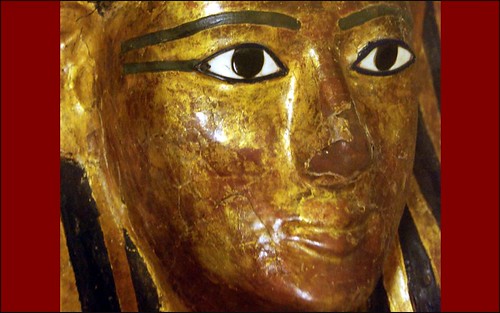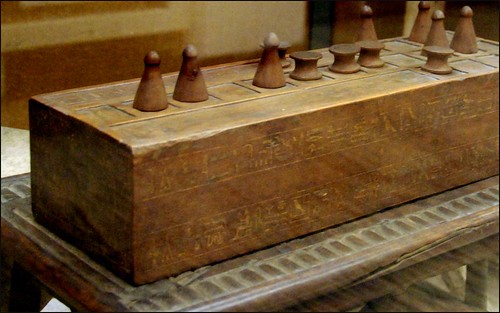Sebekhotep VI
De Wikipedia, la enciclopedia libre
Merhetepra Sebekhotep, o Sebekhotep VI, fue un faraón de la dinastía XIII de Egipto, que gobernó de c. 1656 a 1654 a. C.[1]
Posiblemente era hermano de su predecesor, Sebekhotep V, y su madre fuese Nubhotepti.
Su reinado duró entre dos y cinco años y le sucedió Ibiau.
En el Canon Real de Turín figura como Merhetepra, en el registro VII.4, consignando un reinado de dos años, dos meses y nueve días.
Su nombre de Trono fue Merhetepra "El que ama y está en paz con Ra" y el nombre de Nacimiento Sebekhotep "Sobek está satisfecho".
Franke lo identifica con un rey llamado Ini, basandose en un escarabeo con el nombre de Trono de Sebekhotep y el de Nacimiento Ini, que habría reinado 2 años, 2 meses y 9 días. Von Beckerath y Spalinger no están de acuerdo con esta teoría.
Contenido |
Testimonios de su época [editar]
De este gobernante se han encontrado referencias en:
- Canon Real de Turín,
- Lista Real de Karnak,
- una estatua, en Karnak,
- una estela, en Karnak (llamada Estela jurídica),
- una estela, en Abidos.
Titulatura [editar]
| Titulatura | Jeroglífico | Transliteración (transcripción) - traducción - (procedencia) |
| Nombre de Nesut-Bity: |
| mr ḥtp rˁ (Merhetepra) El que ama y está en paz con Ra[2] |
| Nombre de Nesut-Bity: |
| mr ḥtp rˁ (Merhetepra) El que ama y está en paz con Ra[3] |
| Nombre de Sa-Ra: |
| sbk ḥtp (Sebek Hotep) Sobek está satisfecho (Museo de El Cairo Nº 42038) |
| Nombre de Sa-Ra: |
| i ni (Ini) Ini (Louvre, 3310) (según Franke) |
Referencias [editar]
- Notas
- ↑ Franke: op. cit. p. 60.
- ↑ Museo de El Cairo nº 42038
- ↑ Canon Real de Turín nº 7,4
- Referencias digitales
- http://www.narmer.pl/dyn/13en.htm (en inglés)
Bibliografía [editar]
- von Beckerath, Jürgen (1964). Untersuchungen zur politischen Geschichte der zweiten Zwischenzeit in Ägypten. Ed. J.J. Augustin, pp. 60. ISBN 3-87030-059-0.
| Predecesor: Merneferra | Faraón Dinastía XIII | Sucesor: Suadyetu |
En otros idiomas
| |
Galeria de Hans Ollermann
Deir el-Medina.
2008_0610_163049AA Egyptian Museum, Turin

Gilded coffin from the Tomb of Kha (TT8), Deir el-Medina.
Dynasty XVIII, Reign of Amenhotep II, Tuthmose IV, & Amenhotep III.
(text info from Su, London.)
Tomb of Kha and his wife Merit.
Kha was architect of the Pharaoh (Amenhotep II 18th Dynasty) and responsible for building projects not just in the reign of Amenhotep II, but also in the reign of 3 or 4 kings: Tuthmosis III, Amenhotep II, Tuthmosis IV and Amenhotep III
The intact tomb was discovered by E. Schiaparelli in 1906.
The access shaft to the funerary chamber was neither located in the chapel nor in the courtyard, but at a certain distance from both.
The collapse of a nearby Ramesside tomb had hidden it completely, thus preserving the burial intact through the course of 33 centuries.
A staircase led to a corridor and ante-chamber.
The funerary provisions were placed here because there was no room in the burial chamber itself at the time of the burial.
A bed, two baskets, two amphora's and a chair were also in this ante-chamber.
The entrance to the funeral chamber was blocked by a heavy wooden door that was closed on the in-side.
The chamber itself was rectangular with smooth plastered walls.
The great rectangular sarcophagi were inside, placed along the walls and covered with linen sheets.
A statue of Kha was on a chair, which stood in front of the sarcophagus of Merit.
It was garlanded with flowers.
Egyptian Museum, Turin.
2008_0610_164313AA Egyptian Museum, Turin

Gilded coffin from the Tomb of Kha (TT8), Deir el-Medina.
Dynasty XVIII, Reign of Amenhotep II, Tuthmose IV, & Amenhotep III.
(text info from Su, London.)
Tomb of Kha and his wife Merit.
Kha was architect of the Pharaoh (Amenhotep II 18th Dynasty) and responsible for building projects not just in the reign of Amenhotep II, but also in the reign of 3 or 4 kings: Tuthmosis III, Amenhotep II, Tuthmosis IV and Amenhotep III
The intact tomb was discovered by E. Schiaparelli in 1906.
The access shaft to the funerary chamber was neither located in the chapel nor in the courtyard, but at a certain distance from both.
The collapse of a nearby Ramesside tomb had hidden it completely, thus preserving the burial intact through the course of 33 centuries.
A staircase led to a corridor and ante-chamber.
The funerary provisions were placed here because there was no room in the burial chamber itself at the time of the burial.
A bed, two baskets, two amphora's and a chair were also in this ante-chamber.
The entrance to the funeral chamber was blocked by a heavy wooden door that was closed on the in-side.
The chamber itself was rectangular with smooth plastered walls.
The great rectangular sarcophagi were inside, placed along the walls and covered with linen sheets.
A statue of Kha was on a chair, which stood in front of the sarcophagus of Merit.
It was garlanded with flowers.
Egyptian Museum, Turin.
2008_0610_162915AA Gilded coffin from the Tomb of Kha (TT8), Deir el-Medina

Gilded coffin from the Tomb of Kha (TT8), Deir el-Medina.
Dynasty XVIII, Reign of Amenhotep II, Tuthmose IV, & Amenhotep III.
(text info from Su, London.)
Tomb of Kha and his wife Merit.
Kha was architect of the Pharaoh (Amenhotep II 18th Dynasty) and responsible for building projects not just in the reign of Amenhotep II, but also in the reign of 3 or 4 kings: Tuthmosis III, Amenhotep II, Tuthmosis IV and Amenhotep III
The intact tomb was discovered by E. Schiaparelli in 1906.
The access shaft to the funerary chamber was neither located in the chapel nor in the courtyard, but at a certain distance from both.
The collapse of a nearby Ramesside tomb had hidden it completely, thus preserving the burial intact through the course of 33 centuries.
A staircase led to a corridor and ante-chamber.
The funerary provisions were placed here because there was no room in the burial chamber itself at the time of the burial.
A bed, two baskets, two amphora's and a chair were also in this ante-chamber.
The entrance to the funeral chamber was blocked by a heavy wooden door that was closed on the in-side.
The chamber itself was rectangular with smooth plastered walls.
The great rectangular sarcophagi were inside, placed along the walls and covered with linen sheets.
A statue of Kha was on a chair, which stood in front of the sarcophagus of Merit.
It was garlanded with flowers.
Egyptian Museum, Turin.
2008_0610_162608AA Egyptisch Museum, Turijn

Gilded coffin from the Tomb of Kha (TT8), Deir el-Medina.
Dynasty XVIII, Reign of Amenhotep II, Tuthmose IV, & Amenhotep III.
(text info from Su, London.)
Tomb of Kha and his wife Merit.
Kha was architect of the Pharaoh (Amenhotep II 18th Dynasty) and responsible for building projects not just in the reign of Amenhotep II, but also in the reign of 3 or 4 kings: Tuthmosis III, Amenhotep II, Tuthmosis IV and Amenhotep III
The intact tomb was discovered by E. Schiaparelli in 1906.
The access shaft to the funerary chamber was neither located in the chapel nor in the courtyard, but at a certain distance from both.
The collapse of a nearby Ramesside tomb had hidden it completely, thus preserving the burial intact through the course of 33 centuries.
A staircase led to a corridor and ante-chamber.
The funerary provisions were placed here because there was no room in the burial chamber itself at the time of the burial.
A bed, two baskets, two amphora's and a chair were also in this ante-chamber.
The entrance to the funeral chamber was blocked by a heavy wooden door that was closed on the in-side.
The chamber itself was rectangular with smooth plastered walls.
The great rectangular sarcophagi were inside, placed along the walls and covered with linen sheets.
A statue of Kha was on a chair, which stood in front of the sarcophagus of Merit.
It was garlanded with flowers.
Egyptian Museum, Turin.
2008_0610_163748AA Egyptian Museum, Turin

Game of draughts with a little drawer to hold the pieces. From the Tomb of Kha (TT8), Deir el-Medina.
Dynasty XVIII, Reign of Amenhotep II, Tuthmose IV, & Amenhotep III.
(text Su, London)
Tomb of Kha and his wife Merit.
Kha was architect of the Pharaoh (Amenhotep II 18th Dynasty) and responsible for building projects not just in the reign of Amenhotep II, but also in the reign of 3 or 4 kings: Tuthmosis III, Amenhotep II, Tuthmosis IV and Amenhotep III
The intact tomb was discovered by E. Schiaparelli in 1906.
The access shaft to the funerary chamber was neither located in the chapel nor in the courtyard, but at a certain distance from both.
The collapse of a nearby Ramesside tomb had hidden it completely, thus preserving the burial intact through the course of 33 centuries.
A staircase led to a corridor and ante-chamber.
The funerary provisions were placed here because there was no room in the burial chamber itself at the time of the burial.
A bed, two baskets, two amphora's and a chair were also in this ante-chamber.
The entrance to the funeral chamber was blocked by a heavy wooden door that was closed on the in-side.
The chamber itself was rectangular with smooth plastered walls.
The great rectangular sarcophagi were inside, placed along the walls and covered with linen sheets.
A statue of Kha was on a chair, which stood in front of the sarcophagus of Merit.
It was garlanded with flowers.
Egyptian Museum, Turin.




![X1 [t] t](http://es.wikipedia.org/w/extensions/wikihiero/img/hiero_X1.png)
![Q3 [p] p](http://es.wikipedia.org/w/extensions/wikihiero/img/hiero_Q3.png)

![D21 [r] r](http://es.wikipedia.org/w/extensions/wikihiero/img/hiero_D21.png)







No hay comentarios:
Publicar un comentario